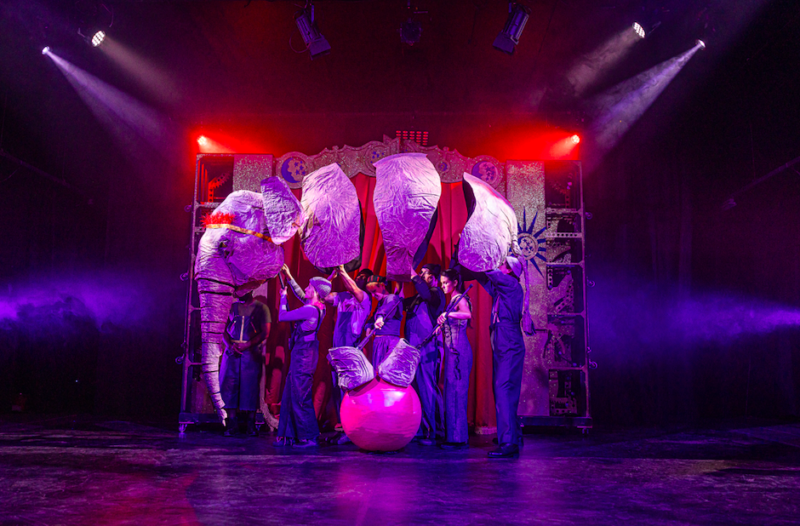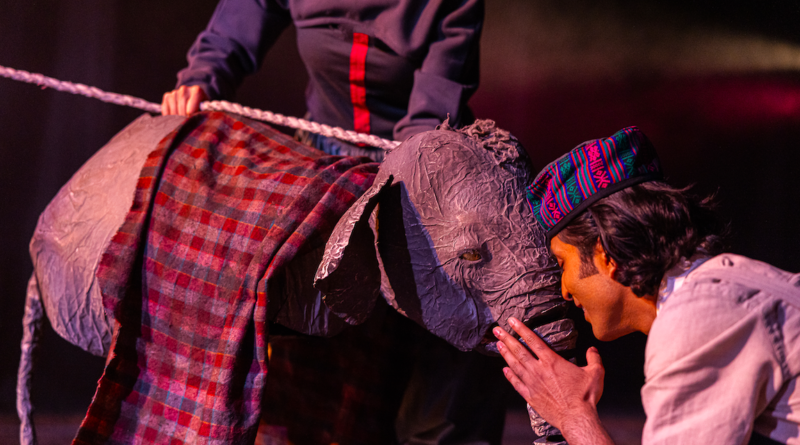INTERVIEW: See this ‘Elephant’ show before it vanishes for good
Photo: The Vanishing Elephant is currently playing at Stage 42 in New York City. Photo courtesy of Melissa Gordon / Provided by Rubenstein with permission.
The New Victory Theater, the preeminent New York City location for family-based entertainment, is currently hosting a run of The Vanishing Elephant, a new puppet show from the creative minds at Cahoots NI, based in Belfast, Northern Ireland. The kid-friendly extravaganza, which plays Stage 42, follows the journey of Jenny, an elephant ripped from her homeland of India and brought to the United States to perform in a circus. Audiences, young and old, watch as Jenny tries to get back to her family and friends, including her best friend Opu.
The show, which continues through Sunday, Oct. 29, at the Midtown Manhattan venue, is actually based on real events. Harry Houdini, the famed magician, had a recurring act where he made an elephant named Jenny vanish on stage. The piece also delves into the sad history of elephants who worked for less-than-stellar circus companies. The play, written by Charles Way, is directed by Paul Bosco McEneaney, with music from Aoife Kavanagh and MD Pallavi. McEneaney pulls double duty as Cahoots’ artistic director.
Recently Hollywood Soapbox exchanged emails with Helen Foan, master puppeteer for the show who also heads Foan & Fortune Theatre Company. Her previous work has been featured at Blind Summit Theatre Company, Seven Stages Shakespeare and Barmpot Theatres, among many other companies. She has brought to life puppetry for The Wizard of Oz, 101 Dalmatians, Dinosaur World Live and Henry V at Shakespeare’s Globe. Questions and answers have been slightly edited for style.
What unique challenges were presented with the puppet creation for The Vanishing Elephant?
What’s exciting for me as a designer are the amazing things that the puppets get to do in the story. Our elephant Janu begins as a newborn calf, and then we see her at three stages in her life, from baby to fully-grown Asian elephant. Because of this I needed to think about how she could grow, then how she could carry someone on her back, roll in the mud and do a full circus routine where she stands on her head! For a puppet the size of a fully grown elephant, that’s quite a design challenge.
What does “day one” look like for puppet design? How do you start and put pen to paper?
I start with reading the script and making a note of all of the major movements the puppet will need to perform in the show as this affects the whole design. Then begins my favourite part of the process, watching hundreds of YouTube videos of elephants and baby elephants! Next, I begin sketching shapes and preparing for a research and development process where I will build a prototype from cardboard and play in a room with puppeteers.
Compared to other animals, is bringing to life an elephant on stage difficult?
The main challenge of an elephant puppet is the size. Even a baby elephant is quite a big puppet! My task as a designer is making something strong but light enough for the ensemble to play with. The skill is in the puppeteering, making the light collection of abstract shapes move together and feel like one big, heavy, muscular elephant. Our ensemble, led by the brilliant Ashleigh Cheadle and Iris Schmid, do a fantastic job of bringing the energy and emotion of an elephant to life.
Is puppetry a universal language loved by all ages and all cultures? It would seem that the art form breaks down many barriers.
I believe puppetry is a hugely unifying art form for an audience. It asks an audience to use their imagination, and universal ideas like breath and rhythm, to connect to the emotions of the puppet character regardless of their age and spoken language. Our family audience can relate to Janu instinctively and follow her emotional journey through the story.
Is puppetry going through a new renaissance? It seems like more and more stage productions are using this art form.
Puppetry is an umbrella term for so many amazing art forms and is being embraced as a tool for storytelling more and more. It allows us to be ambitious and endlessly creative with the scale of the stories we tell. For me, it epitomizes the joy of live theatre as it requires your audience to invest their own imagination and have a more active role in connecting to a story.
What are you currently working on?
I have two shows in development with my puppetry company Foan & Fortune. We have a family theatre piece called Mess!, which uses clown, music and puppetry to tell a big adventure on a small scale. Our second show called This is me looks at the experiences of people living with young-onset dementia though puppetry and object manipulation. What I love about puppetry is the variety and creativity it brings to exploring stories.
By John Soltes / Publisher / John@HollywoodSoapbox.com
The Vanishing Elephant, featuring the puppetry of Helen Foan, continues through Sunday, Oct. 29, at Stage 42 in Midtown Manhattan. Click here for more information and tickets.


